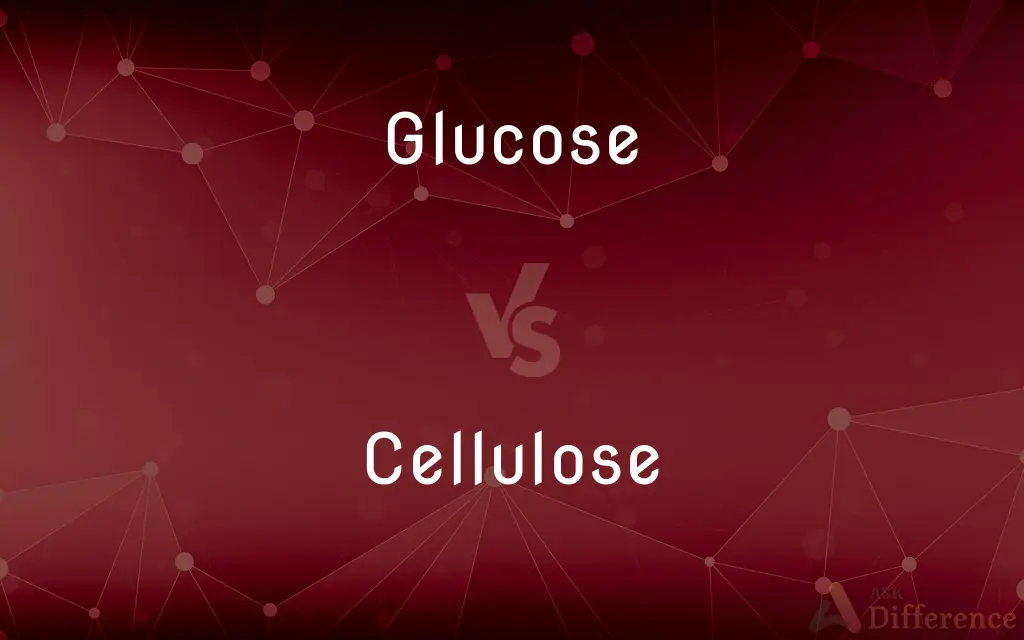Glucose vs. Cellulose — What's the Difference?
By Maham Liaqat & Urooj Arif — Updated on April 18, 2024
Glucose is a simple sugar and a primary energy source for cells, while cellulose is a complex carbohydrate and structural component of plant cell walls.

Difference Between Glucose and Cellulose
Table of Contents
ADVERTISEMENT
Key Differences
Glucose is a monosaccharide, meaning it consists of a single sugar unit and is directly involved in cellular metabolism. Whereas, cellulose is a polysaccharide made up of long chains of glucose units, primarily providing structural support to plants.
Glucose is soluble in water, facilitating its role in the bloodstream as an energy carrier. On the other hand, cellulose is insoluble in water, contributing to its function in providing rigidity and strength to plant structures.
In human nutrition, glucose is essential as it serves as a vital energy source, quickly metabolized by the body. Whereas cellulose, though indigestible by humans, acts as dietary fiber that aids in digestion and maintaining gut health.
Chemically, glucose molecules are linked by α-glycosidic bonds in starch or in free form in fruits and other foods. In contrast, the glucose units in cellulose are linked by β-glycosidic bonds, which make it tough and resistant to digestion.
In terms of usage, glucose is extensively used in the food industry as a sweetener and a preservative, enhancing flavor and extending shelf life of foods. Cellulose, however, is used in the manufacture of paper products, textiles, and as a food additive to provide texture and bulk.
ADVERTISEMENT
Comparison Chart
Type of Carbohydrate
Monosaccharide
Polysaccharide
Solubility
Soluble in water
Insoluble in water
Role in Nutrition
Primary energy source
Provides dietary fiber
Chemical Bonding
α-glycosidic bonds
β-glycosidic bonds
Common Uses
Sweetener, food preservative
Paper manufacture, food additive
Compare with Definitions
Glucose
A component of many carbohydrates found naturally in fruits and vegetables.
Glucose is abundant in fruits like grapes and bananas.
Cellulose
A complex carbohydrate that forms the structural component of plant cell walls.
Cellulose makes up about 33% of all plant matter.
Glucose
A simple sugar that is an important energy source in living organisms.
Glucose levels in the blood rise after eating a meal.
Cellulose
Can be chemically modified to create products such as cellophane and rayon.
Cellulose derivatives are used in film and fiber production.
Glucose
Commercially used as a sweetener in various food products.
Glucose syrup is often added to ice cream to prevent crystallization.
Cellulose
Indigestible by humans but crucial for dietary fiber.
Dietary fiber in vegetables comes largely from cellulose.
Glucose
Measured in medical contexts to monitor blood sugar levels.
Diabetic patients regularly check their glucose levels.
Cellulose
Used to produce paper and various textiles like cotton.
Cotton is almost pure cellulose, making it durable and absorbent.
Glucose
Can be produced synthetically from starch.
Industrial glucose is derived from corn starch through hydrolysis.
Cellulose
Acts as a food additive for anti-caking and bulking.
Cellulose is added to shredded cheese to prevent clumping.
Glucose
Glucose is a simple sugar with the molecular formula C6H12O6. Glucose is the most abundant monosaccharide, a subcategory of carbohydrates.
Cellulose
Cellulose is an organic compound with the formula (C6H10O5)n, a polysaccharide consisting of a linear chain of several hundred to many thousands of β(1→4) linked D-glucose units. Cellulose is an important structural component of the primary cell wall of green plants, many forms of algae and the oomycetes.
Glucose
A simple sugar which is an important energy source in living organisms and is a component of many carbohydrates.
Cellulose
A polysaccharide, (C6H10O5)n, that is composed of glucose monomers and is the main constituent of the cell walls of plants. It is used in the manufacture of numerous products, including paper, textiles, pharmaceuticals, and insulation.
Glucose
A colorless to yellowish syrupy mixture of dextrose, maltose, and dextrins containing about 20 percent water, used in confectionery, alcoholic fermentation, tanning, and treating tobacco. Also called starch syrup.
Cellulose
A complex carbohydrate that forms the main constituent of the cell wall in most plants and is important in the manufacture of numerous products, such as paper, textiles, pharmaceuticals, and explosives.
Glucose
(carbohydrate) A simple monosaccharide (sugar) with a molecular formula of C6H12O6; it is a principle source of energy for cellular metabolism.
Cellulose
(organic compound) A polysaccharide containing many glucose units in parallel chains.
Glucose
A variety of sugar occurring in nature very abundantly, as in ripe grapes, and in honey, and produced in great quantities from starch, etc., by the action of heat and acids. It is only about half as sweet as cane sugar. Called also dextrose, grape sugar, diabetic sugar, and starch sugar. See Dextrose.
Cellulose
Consisting of, or containing, cells.
Glucose
Any one of a large class of sugars, isometric with glucose proper, and including levulose, galactose, etc.
Cellulose
Consisting of, or containing, cells.
Glucose
The trade name of a sirup, obtained as an uncrystallizable reside in the manufacture of glucose proper, and containing, in addition to some dextrose or glucose, also maltose, dextrin, etc. It is used as a cheap adulterant of sirups, beers, etc.
Cellulose
The substance which constitutes the essential part of the solid framework of plants, of ordinary wood, cotton, linen, paper, etc. It is also found to a slight extent in certain animals, as the tunicates. It is a carbohydrate, (C6H10O5)n, isomeric with starch, and is convertible into starches and sugars by the action of heat and acids. When pure, it is a white amorphous mass. See Starch, Granulose, Lignin.
Unsized, well bleached linen paper is merely pure cellulose.
Glucose
A monosaccharide sugar that has several forms; an important source of physiological energy
Cellulose
A polysaccharide that is the chief constituent of all plant tissues and fibers
Common Curiosities
What is the main difference between glucose and cellulose?
Glucose is a simple sugar used for energy, while cellulose is a complex sugar that provides structural support in plants.
Is cellulose useful in any medical applications?
Yes, cellulose is used in medical applications, particularly in the production of medical textiles and wound care products.
How do plants use cellulose?
Plants use cellulose to build their cell walls, which provides rigidity and strength to the plant structure.
What role does cellulose play in the environment?
Cellulose is biodegradable and plays a crucial role in the carbon cycle, decomposing back into the environment.
Can humans digest cellulose?
No, humans cannot digest cellulose as it requires enzyme cellulase, which humans lack.
Why is glucose important for humans?
Glucose is crucial as it provides the primary energy source for our cells and is critical for brain function.
Are there synthetic forms of cellulose?
Yes, cellulose derivatives like cellulose acetate are synthetically modified forms used in plastics and films.
What foods are high in glucose?
Fruits, honey, and sweets are typically high in glucose.
How is cellulose extracted for industrial use?
Cellulose is extracted from plant fibers through a process that removes lignin and other components.
What is the difference in the molecular structure between glucose and cellulose?
The main difference is in the linkage of glucose molecules; α-glycosidic in glucose vs. β-glycosidic in cellulose.
What is the primary function of glucose in plants?
In plants, glucose is a product of photosynthesis and serves as an energy source and a building block for other important compounds.
Can glucose be converted into cellulose in nature?
Yes, plants convert glucose into cellulose for their cell walls via enzymatic processes.
How does the insolubility of cellulose affect its function in plants?
The insolubility of cellulose makes it ideal for providing water-resistant structural support in plant cell walls.
Share Your Discovery

Previous Comparison
Oregano vs. Zaatar
Next Comparison
Rack vs. StackAuthor Spotlight
Written by
Maham LiaqatCo-written by
Urooj ArifUrooj is a skilled content writer at Ask Difference, known for her exceptional ability to simplify complex topics into engaging and informative content. With a passion for research and a flair for clear, concise writing, she consistently delivers articles that resonate with our diverse audience.
















































